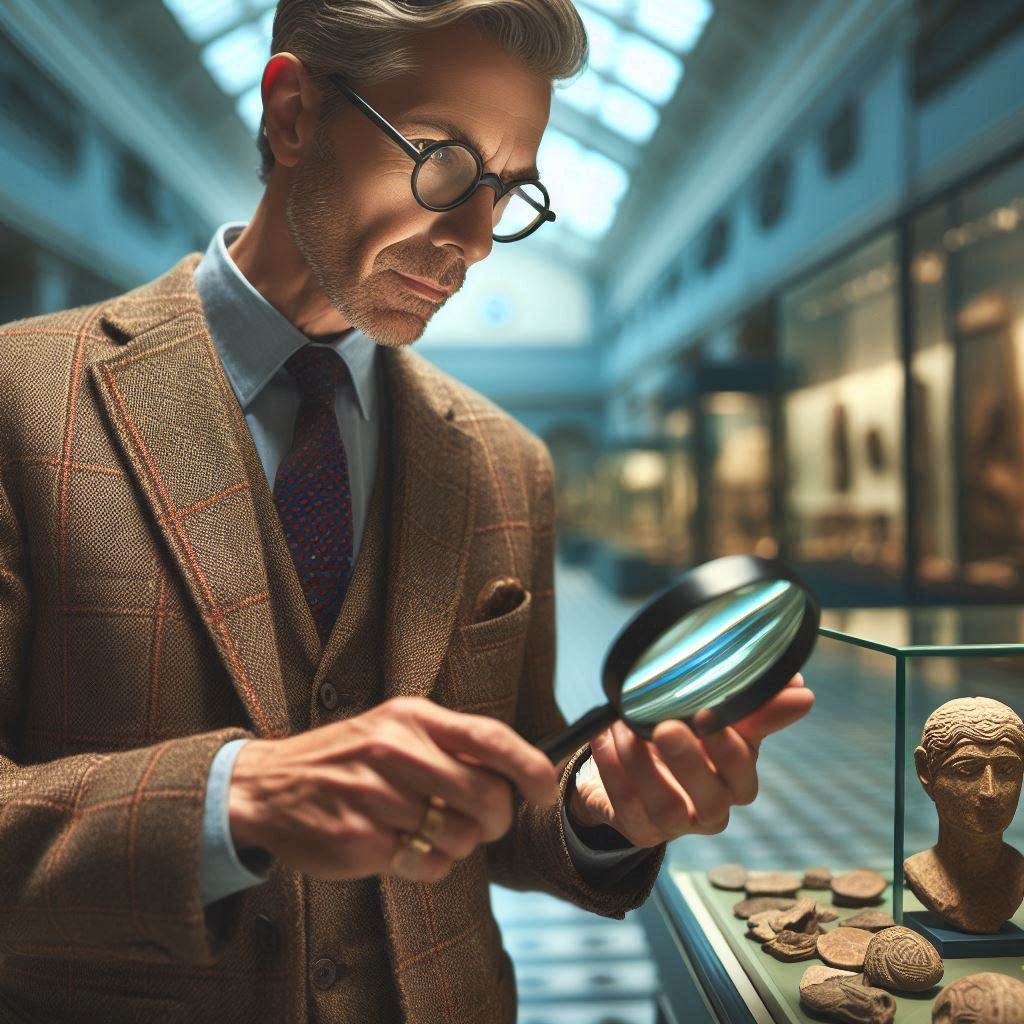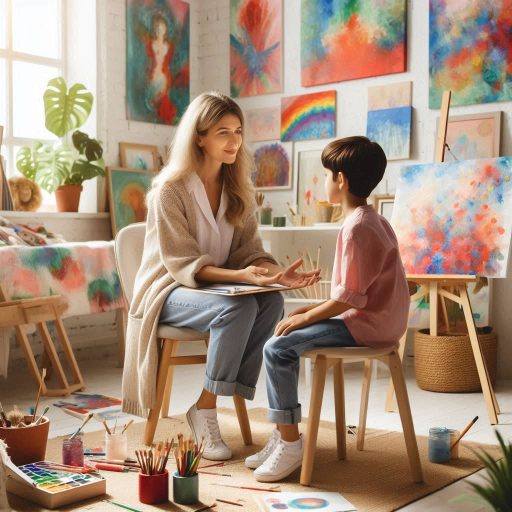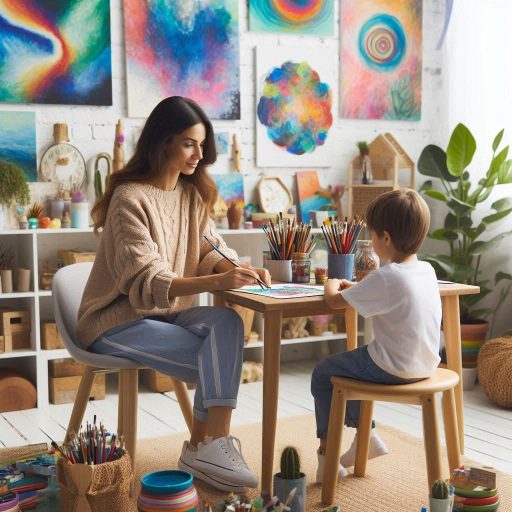Introduction
Curators play a vital role in the art world by selecting and organizing artworks for exhibitions.
They connect artists with audiences, creating meaningful experiences through art.
By curating exhibitions, curators shape narratives that enhance viewer engagement and understanding.
The importance of curators extends beyond mere selection.
They enhance public appreciation of art, making it accessible to diverse audiences.
Their expertise influences how audiences perceive and interact with artworks, shaping cultural conversations.
When selecting artworks, curators consider several key factors.
First, they determine the exhibition’s theme and concept, guiding their choices.
Next, they prioritize diversity and inclusivity, showcasing various perspectives and voices.
Curators also evaluate the artistic quality and craftsmanship of the works.
Relevance to the audience is crucial in the selection process.
Curators tailor their choices to engage and educate viewers effectively.
Finally, they analyze the context of each artwork, considering historical and cultural significance.
By thoughtfully evaluating these factors, curators create impactful exhibitions that resonate with audiences and foster a deeper appreciation for art.
Theme and Concept
Curators Start by Determining the Theme or Concept of the Exhibition
Curators begin their work by determining the theme or concept for an exhibition.
This foundational step sets the tone for the entire showcase.
A well-defined theme helps guide the selection of artworks, ensuring coherence and a unified message.
The theme acts as a lens through which viewers will interpret the pieces displayed.
Choosing the right theme is crucial for curators.
It not only influences the artworks selected but also engages the audience.
Themes can be broad, such as “Identity,” or more specific, like “Nature and Technology.”
The theme shapes the narrative and context for each artwork, allowing for deeper connections and discussions.
The Theme Sets the Tone and Guides for the Selection of Artworks
For instance, the renowned exhibition “The Clock” by Christian Marclay presented a strong theme of time.
This work included thousands of film clips, each showing a clock at a specific hour.
The theme resonated with audiences as they experienced time passing in real-time.
This exhibition exemplifies how a clear theme can elevate the viewer’s experience.
Another successful example is “The Future of Tradition” at the Asian Art Museum.
This exhibition explored contemporary Asian art while reflecting on traditional influences.
The theme allowed curators to select diverse works that showcased the evolution of artistic practices.
Visitors could see the dialogue between past and present, enhancing their understanding of the artworks.
The theme can also serve as a focal point for curatorial research.
Curators often spend months gathering insights and selecting artworks that align with the theme.
They explore various artists and mediums to ensure a well-rounded representation.
This process involves extensive discussions and collaborations with artists, collectors, and other institutions.
A strong theme encourages curators to be innovative in their approach.
They might include lesser-known artists to create unexpected connections.
This choice can challenge traditional narratives and provoke thought among viewers.
Curators can transform the exhibition space into an immersive experience that invites exploration.
Examples of Successful Exhibitions Driven by a Strong Theme
Moreover, a captivating theme can attract a broader audience.
By tapping into current issues or trends, curators engage viewers beyond the art world.
For example, exhibitions addressing climate change have drawn attention from environmental activists and art enthusiasts alike.
The ability to resonate with contemporary concerns makes the theme relevant and impactful.
The theme and concept play a vital role in how curators select artworks for exhibitions.
A well-defined theme sets the tone and direction for the entire event.
It fosters connections between the artworks and the audience, enhancing their experience.
Successful exhibitions like “The Clock” and “The Future of Tradition” showcase the power of a strong theme.
Curators must continually explore and innovate, ensuring that their exhibitions resonate with viewers while celebrating the art.
Read: Top Skills Needed for a Successful Character Designer
Diversity and Inclusivity
Curators Aim to Showcase Diverse Perspectives and Voices in Exhibitions
Curators strive to showcase diverse perspectives and voices in their exhibitions.
They recognize that art is enriched by different cultural backgrounds and experiences.
A variety of viewpoints allows audiences to engage with artwork on multiple levels.
This approach fosters a deeper understanding and appreciation of the art presented.
Curators believe that diversity in art enhances the relevance and impact of exhibitions.
By featuring works from underrepresented artists, curators challenge conventional narratives.
They can illuminate stories and experiences that might otherwise remain hidden.
This commitment to diversity encourages conversations around social, political, and cultural issues.
Exhibitions become platforms for dialogue, reflecting the complexities of contemporary society.
Curators play a critical role in expanding the narrative of the art world through inclusivity.
Inclusivity in Terms of Artists‘ Backgrounds, Mediums, and Styles
Inclusivity encompasses various aspects, including artists’ backgrounds, mediums, and styles.
Curators actively seek to include artists from different ethnicities, genders, and socioeconomic backgrounds.
This focus creates a more equitable representation within the art community.
It allows for a richer tapestry of artistic expression, appealing to a broader audience.
In addition to diverse backgrounds, curators consider the range of artistic mediums.
Including traditional forms, such as painting and sculpture, alongside newer mediums like digital art or installation ensures variety.
This approach highlights the evolving nature of art and its ability to adapt to contemporary issues.
Moreover, curators explore different artistic styles, from realism to abstract, allowing for a dynamic viewing experience.
Strategies for Curators to Ensure Diversity in Their Selections
To ensure diversity in their selections, curators employ various strategies.
They actively research and network within diverse communities.
Building relationships with artists from various backgrounds can lead to unique opportunities for collaboration.
Curators may also attend artist talks, exhibitions, and fairs that highlight underrepresented voices.
This practice broadens their understanding of the current artistic landscape.
Curators can implement guidelines that prioritize diversity in their selection processes.
Establishing criteria that evaluate artworks based on inclusivity can help maintain a balanced representation.
Additionally, curators can form advisory boards composed of individuals from various backgrounds.
These boards can provide insights and recommendations, ensuring a broader perspective in exhibition planning.
Another effective strategy is to create thematic exhibitions focused on specific cultures or social issues.
By highlighting these topics, curators can showcase artists who address relevant concerns.
These exhibitions can serve as educational tools, fostering awareness and appreciation among audiences.
Diversity and inclusivity are essential considerations for curators in exhibitions.
By showcasing a variety of perspectives, backgrounds, and mediums, curators enrich the art world.
Their commitment to inclusivity helps challenge traditional narratives while promoting a more equitable representation.
Employing effective strategies ensures that exhibitions resonate with a broader audience.
Ultimately, curators have the power to shape the narrative of art, making it more diverse and inclusive.
Read: Career Paths in Ceramic Art and Design
Artistic Quality
Curators Assess the Artistic Quality and Craftsmanship of Artworks
Curators prioritize assessing the artistic quality and craftsmanship of artworks.
This evaluation ensures that the exhibition showcases pieces that demonstrate exceptional skill and creativity.
Artistic quality plays a critical role in attracting and engaging audiences.
Curators strive to select works that not only resonate with viewers but also reflect a high standard of artistry.
When evaluating artworks, curators closely examine various aspects, including technique and execution.
They assess the materials used, the intricacy of details, and the overall composition.
A well-executed piece often reflects the artist’s mastery of their craft, enhancing its appeal.
Curators seek to highlight works that push boundaries and challenge conventional norms.
Criteria for Evaluating the Technical Skills and Creativity of Artists
Curators establish specific criteria for evaluating the technical skills and creativity of artists.
They consider the originality of concepts, the effectiveness of execution, and the overall impact of the artwork.
An artwork’s ability to provoke thought or evoke emotion is crucial in this evaluation process.
Curators look for pieces that spark dialogue and encourage viewers to reflect on their experiences.
Additionally, the context of the artwork matters.
Curators consider how the piece fits within current artistic trends and conversations.
Understanding the cultural and historical significance of an artwork enhances its value.
Curators often engage in discussions with artists to gain insights into their creative processes and intentions.
This dialogue helps curators appreciate the nuances of each piece, allowing for informed selections.
Balancing Between Established and Emerging Artists in Exhibitions
Balancing between established and emerging artists is essential for curators.
Showcasing renowned artists adds credibility and attracts audiences, while featuring emerging talents brings fresh perspectives.
This mix creates a dynamic exhibition that appeals to a diverse audience.
Curators recognize that emerging artists often challenge established norms, contributing to innovation within the art world.
Curators may designate specific sections of an exhibition to emerging artists.
This strategy highlights new voices and provides them with opportunities for exposure.
By doing so, curators can create a platform for dialogue between established and emerging artists.
This interaction enriches the overall experience for viewers, encouraging discussions around different artistic approaches.
Incorporating a diverse range of artists also fosters a sense of inclusivity.
Audiences can engage with various styles and concepts, broadening their understanding of contemporary art.
Curators play a vital role in facilitating this exchange, ensuring that the exhibition reflects the richness of the artistic landscape.
Artistic quality is a fundamental consideration for curators in their selection process.
By assessing the craftsmanship, technical skills, and creativity of artworks, curators ensure that exhibitions resonate with audiences.
Establishing clear evaluation criteria enhances the curatorial process and promotes a balanced representation of artists.
Balancing established and emerging artists enriches the exhibition experience, fostering dialogue and appreciation for diverse artistic expressions.
Ultimately, curators have the responsibility to showcase high-quality art that inspires and engages viewers.
Read: Freelance Character Design: How to Get Started

Relevance to Audience
Curators Consider the Preferences and Interests of the Target Audience
Curators prioritize the preferences and interests of their target audience when selecting artworks.
Understanding the audience’s tastes helps create exhibitions that resonate and engage viewers.
This focus ensures that the artwork presented is relevant and meaningful to those who visit the exhibition.
Curators often conduct research to gain insights into audience demographics and cultural backgrounds.
By considering the audience’s interests, curators can create a more inclusive and inviting atmosphere.
Engaging the audience fosters a deeper connection between the artwork and viewers.
When curators align their selections with audience preferences, they increase the likelihood of a positive reception.
This understanding allows for the creation of exhibitions that speak to contemporary issues and trends.
Tailoring the Selection to Engage and Educate Viewers
Tailoring the selection of artworks enhances the educational aspect of exhibitions.
Curators strive to engage viewers through thought-provoking themes and relevant topics.
They aim to create a narrative that encourages exploration and reflection.
Incorporating artworks that challenge societal norms or provoke critical thinking can stimulate discussions among audiences.
To facilitate learning, curators may provide additional resources, such as exhibition guides or educational programs.
These resources can help contextualize the artworks and deepen viewers‘ understanding.
By framing the selection with educational goals in mind, curators empower audiences to engage with the art on multiple levels.
This approach encourages critical conversations about the themes presented and their relevance to everyday life.
How Feedback from Past Exhibitions Influences Future Selections
Feedback from past exhibitions plays a crucial role in shaping future selections.
Curators often gather responses from visitors to assess what resonated and what did not.
This feedback provides valuable insights into audience preferences and expectations.
Curators analyze visitor surveys, comments, and attendance records to refine their selection processes.
Positive feedback can reinforce curatorial strategies that successfully engaged audiences.
Conversely, constructive criticism highlights areas for improvement and adaptation.
This iterative process allows curators to continually enhance the relevance of their exhibitions.
By learning from past experiences, curators can make informed decisions that align with audience interests.
In addition to formal feedback, curators may engage in informal conversations with visitors.
These discussions can reveal firsthand perspectives on the exhibition’s impact.
Listening to audiences helps curators understand their needs and expectations more comprehensively.
This direct engagement fosters a sense of community and connection between curators and viewers.
Relevance to the audience is a vital consideration for curators in their selection process.
By prioritizing audience preferences and interests, curators can create engaging and educational exhibitions.
Tailoring selections encourages deeper connections and critical conversations among viewers.
Feedback from past exhibitions informs curatorial decisions, allowing for continuous improvement and adaptation.
Ultimately, curators have the opportunity to shape meaningful experiences that resonate with their audiences while showcasing the power of art.
Read: Career Paths: Becoming a Professional Character Designer
Context and Interpretation
Curators Analyze the Historical and Cultural Contexts of Artworks
Curators analyze the historical and cultural contexts of artworks to enrich the viewer’s experience.
Understanding these contexts allows curators to present artworks in a meaningful way.
They explore how the social, political, and historical environments influence the creation of art.
This analysis provides viewers with insights into the motivations and intentions behind the works.
By considering the context, curators can create a narrative that connects the artwork to its time and place.
This contextualization enhances viewers‘ appreciation and understanding of the piece.
Curators may also investigate the artist’s background and influences, adding layers of meaning to the exhibition.
Providing Interpretative Materials to Help Viewers Understand the Significance of the Artworks
Curators provide interpretative materials to help viewers grasp the significance of the artworks.
These materials may include labels, brochures, and digital resources that offer essential information.
Curatorial statements can guide viewers through the exhibition’s themes and objectives.
By explaining key concepts and historical references, curators facilitate a deeper engagement with the art.
Educational programs and guided tours can also enhance understanding.
Curators often host talks or panel discussions to further explore the themes presented.
These initiatives encourage dialogue between artists, curators, and audiences.
By fostering such interactions, curators enhance the overall experience of the exhibition.
Transform Your Career Today
Unlock a personalized career strategy that drives real results. Get tailored advice and a roadmap designed just for you.
Start NowBalancing Between Accessibility and Complexity in Presenting Artworks
Balancing accessibility and complexity is crucial when presenting artworks.
Curators strive to make exhibitions approachable for all audiences, regardless of their prior knowledge.
They use clear language and relatable concepts to convey complex ideas.
This accessibility helps demystify the art and invites broader participation.
However, curators must also respect the depth of the artworks and their contexts.
Providing layered information allows for deeper exploration for those interested.
Curators can offer additional resources for viewers who want to delve deeper into specific themes or concepts.
This approach ensures that both casual visitors and serious art enthusiasts find value in the exhibition.
In designing the exhibition space, curators consider how to present artworks to encourage exploration.
The arrangement of artworks, along with thoughtful signage, can guide viewers through the narrative.
Curators aim to create an immersive experience that invites curiosity while maintaining clarity.
Context and interpretation are essential components of a curator’s role.
By analyzing historical and cultural contexts, curators enrich the viewer’s experience.
Providing interpretative materials enhances understanding and encourages engagement with the artworks.
Balancing accessibility and complexity ensures that exhibitions resonate with diverse audiences.
Ultimately, curators create a space where art can be appreciated, understood, and celebrated, fostering a deeper connection between the viewer and the work.
Collaboration with Artists
Curators Collaborate with Artists to Understand Their Intentions and Perspectives
Curators actively collaborate with artists to gain insights into their intentions and perspectives.
This collaboration is vital for creating an exhibition that accurately represents the artists’ visions.
By engaging in open dialogue, curators can explore the concepts and themes that drive the artwork.
Understanding an artist‘s motivations helps curators communicate their ideas effectively to the audience.
Curators often conduct studio visits or interviews to establish these connections.
These interactions allow curators to ask questions, listen to stories, and learn about the creative process.
This firsthand knowledge enriches the curatorial narrative and provides deeper context for the artworks.
Curators appreciate that each artist brings a unique viewpoint that can shape the exhibition’s direction.
Respecting the Artists‘ Visions While Curating the Exhibition
Respecting the artists’ visions is a fundamental principle in curatorial practice.
Curators understand that the integrity of the artwork must remain intact throughout the exhibition process.
They strive to maintain a balance between the artist’s intent and the overall exhibition theme.
By collaborating closely, curators ensure that the artworks are displayed in a way that honors the artist‘s vision.
This respect fosters a positive working relationship between curators and artists, leading to more meaningful exhibitions.
Curators may seek feedback from artists during the installation process, allowing for adjustments that enhance the presentation.
This collaborative spirit creates a shared sense of ownership over the exhibition.
Examples of Successful Collaborations Between Curators and Artists
Several successful collaborations between curators and artists highlight the impact of this partnership.
One notable example is the collaboration between curator Hans Ulrich Obrist and artist Christian Boltanski.
Their joint projects have explored themes of memory and identity, creating thought-provoking exhibitions that resonate with audiences.
Their discussions and shared insights have resulted in innovative installations that reflect both of their artistic visions.
Another example is the partnership between curator Okwui Enwezor and the artist Ai Weiwei.
Enwezor‘s curation of the 2015 Venice Biennale featured Ai’s powerful installations addressing themes of migration and human rights.
The collaboration emphasized the importance of political context in contemporary art, showcasing how curators and artists can effectively work together.
In addition, the collaboration between curator Ruth Noack and artist Thomas Hirschhorn at the Documenta 14 exhibition exemplifies successful teamwork.
Their combined efforts created immersive environments that challenged viewers‘ perceptions and encouraged participation.
This partnership showcased how curators and artists can co-create impactful experiences that leave a lasting impression on audiences.
Collaboration with artists is a vital aspect of curatorial practice.
By engaging with artists, curators gain valuable insights into their intentions and perspectives.
Respecting the artists‘ visions ensures the integrity of the artwork while creating meaningful exhibitions.
Successful collaborations, like those between notable curators and artists, demonstrate the power of this partnership.
Ultimately, these collaborations enhance the art experience, fostering deeper connections between the artwork, the artist, and the audience.
You Might Also Like: Top Industries Hiring Game Designers in 2024
Explore Further: How to Network in the Industrial Design Industry
Space and Installation
Curators Consider the Exhibition Space and Layout When Selecting Artworks
Curators carefully consider the exhibition space and layout when selecting artworks.
The physical environment plays a crucial role in how artworks are perceived and experienced.
Curators evaluate the dimensions, lighting, and flow of the space to ensure that each piece fits harmoniously within the setting.
This strategic approach allows curators to create an engaging atmosphere that invites exploration.
Different artworks may require specific arrangements based on their size and medium.
Curators assess how the placement of each piece can enhance its visibility and impact.
For instance, larger works may need more expansive spaces to allow for proper appreciation.
By thoughtfully considering these factors, curators can curate a space that elevates the overall exhibition experience.
Creating a Cohesive and Visually Engaging Presentation
Creating a cohesive and visually engaging presentation is essential for a successful exhibition.
Curators strive to establish a clear narrative or theme that connects the selected artworks.
This narrative can guide the viewer’s journey through the exhibition, fostering a deeper understanding of the artworks presented.
Color schemes, materials, and textures also contribute to the cohesiveness of the exhibition.
Curators may use complementary colors or similar materials to create visual harmony.
This attention to detail helps to unify the artworks while allowing each piece to shine individually.
In addition, curators pay attention to how artworks interact with each other.
They consider the relationships between pieces, exploring how they can enhance or contrast with one another.
This thoughtful arrangement can create dialogue between works, prompting viewers to draw connections and engage with the content more deeply.
Importance of Effective Installation to Enhance the Viewer‘s Experience
Effective installation is crucial in enhancing the viewer‘s experience.
Curators understand that the way artworks are presented can significantly influence how audiences perceive and interact with them.
Proper lighting, for example, can highlight specific features and details of the artwork, drawing viewers‘ attention.
Curators also consider the viewing distances required for each piece.
Allowing enough space for viewers to step back and take in the work can enhance appreciation.
Conversely, proximity can encourage closer examination of intricate details.
This balance fosters a more engaging and immersive experience for visitors.
Moreover, curators must ensure that the installation adheres to safety standards.
Protecting the artwork while providing a comfortable viewing experience is paramount.
Clear signage and pathways can guide visitors smoothly through the exhibition, enhancing accessibility.
Space and installation are fundamental considerations in curatorial practice.
By thoughtfully assessing the exhibition space and layout, curators create a visually engaging presentation.
Establishing a cohesive narrative fosters deeper connections between the artworks and the audience.
Effective installation enhances the viewer‘s experience, ensuring that the exhibition leaves a lasting impression.
Ultimately, curators play a vital role in shaping how artworks are experienced, creating spaces that invite exploration and engagement.
Conclusion
Curators consider various key factors when selecting artworks for exhibitions.
These factors include artistic quality, relevancy to the theme, and the overall impact on the audience.
It is essential for curators to strike a balance between showcasing well-established artists and emerging talents to create a diverse and engaging exhibition.
Furthermore, curators must also consider the logistics of displaying artworks, such as space limitations and technical requirements.
Overall, the curatorial process is a blend of creativity and curation.
Curators use their expertise to not only curate a visually appealing exhibition but also to communicate a story or message through the selected artworks.
It is a meticulous process that requires a deep understanding of art history, contemporary art trends, and the ability to identify emerging talents.
As readers, it is important to appreciate the thought and effort that goes into curating exhibitions.
Curators play a vital role in shaping the art world and providing a platform for artists to showcase their work.
By understanding the intricate process behind selecting artworks for exhibitions, we can have a greater appreciation for the art we encounter in galleries and museums.
[E-Books for Sale]
The Big Book of 500 High-Paying Jobs in America: Unlock Your Earning Potential
$19.99 • 500 High-Paying Jobs • 330 pages
Explore 500 high-paying jobs in America and learn how to boost your career, earn more, and achieve success!
See All 500 High-Paying Jobs of this E-Book
1001 Professions Without a Degree: High-Paying American Jobs You Can Start Now
$19.99 • 1001 Professions Without a Degree • 174 pages
Discover 1001 high-paying jobs without a degree! Unlock career tips, skills, and success strategies for just $19.99!




